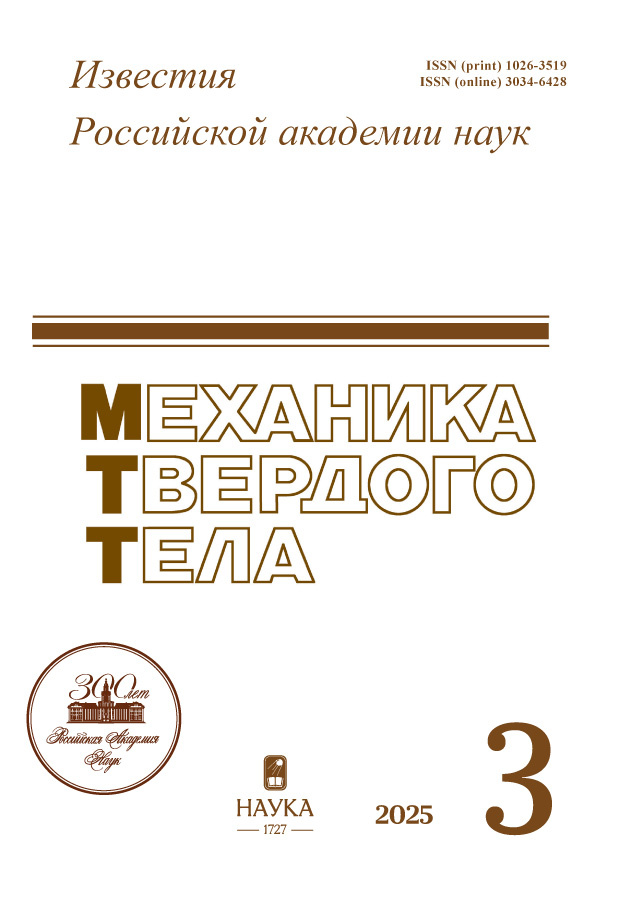Bending of underwater pipeline during lifting
- Autores: Ilgamov M.A.1,2,3
-
Afiliações:
- A.A. Blagonravov Institute of Mechanical Engineering of the RAS
- Institute of Mechanics and Mechanical Engineering of the Kazan Scientific Center of the RAS
- Mavlyutov Institute of Mechanics of the Ufa Federal Research Center of the RAS
- Edição: Nº 3 (2025)
- Páginas: 23-37
- Seção: Articles
- URL: https://transsyst.ru/1026-3519/article/view/687408
- DOI: https://doi.org/10.31857/S1026351925030023
- EDN: https://elibrary.ru/AYZOUD
- ID: 687408
Citar
Texto integral
Resumo
The article considers the bending of a long concrete pipeline when its section is raised to the free surface of a reservoir. The initial horizontal position of the pipeline is rectilinear. Its static bending occurs under the action of concentrated forces, the weights of the pipe and the transported medium, and the lifting force of water. The minimum required value of the lifting force and the corresponding length of the raised section of a long pipeline are determined. Taking into account the large ratio of this length to the depth of the reservoir, a linear bending equation is used. An analysis of the bend is given depending on the controlled lifting force and the controlled rise of the pipeline.
Palavras-chave
Texto integral
Sobre autores
M. Ilgamov
A.A. Blagonravov Institute of Mechanical Engineering of the RAS; Institute of Mechanics and Mechanical Engineering of the Kazan Scientific Center of the RAS; Mavlyutov Institute of Mechanics of the Ufa Federal Research Center of the RAS
Autor responsável pela correspondência
Email: ilgamov@anrb.ru
Rússia, Moscow; Kazan; Ufa
Bibliografia
- Levin S.M. Underwater pipelines. M.: Nedra. 1970. 280 p. [in Russian].
- Palmer A.C., King R.A. Subsea Pipeline Engineering. Oklahoma: PWC. 2004. 570 p.
- Ainbinder A.B. Calculation of main and field pipelines for strength and stability: Reference manual. M.: Nedra. 1991. 287 p. [in Russian].
- Pedersen R.T. Equilibrium of offshore cables and pipelines during laying // Int. Shipbuild Prog. 1975. V. 22. P. 399–408. https://doi.org/10.3233/ISP-1975-2225601
- Guarracino F., Mallardo V. A refined analytical analysis of submerged pipelines in seabed laying. Appl. Ocean Res. 1999. 21. P. 281–293. https://doi.org/10.1016/S0141-1187(99)00020-6
- Ilgamov M.A., Ratrout R.A. Large deflection of superconducting cable // International Journal of Non-Linear Mechanics. 1999. 34. P. 869-880. https://doi.org/10.1016/S0020-7462(98)00059-6
- Ilgamov M.A., Yakubov R.G. Strong bending of a pipeline // Izvestiya RAS. Mechanics of Solids. 2003. № 6. P. 109–116 [in Russian].
- Peek R., Yun H. Flotation to trigger lateral buckles in pipelines on a flat seabed // Journal of Engineering Mechanics. 2007. V. 4. P. 442–451. https://doi.org/10.1061/(ASCE)0733-9399(2007)133:4(442)
- Eliseev V.V., Zinovieva T.V. Nonlinear elastic deformation of an underwater pipeline during laying // Computational Continuous Media Mechanics. 2012. № 1. P. 70–78. https://doi.org/10.7242/1999-6691/2012.5.1.9 [in Russian].
- Wang Z., Tang Y. Study on symmetric buckling mode triggered by dual distributed buoyancy sections for subsea pipelines // Ocean Engineering. 2020. V. 216. P. 105–110. https://doi.org/10.1016/j.oceaneng.2020.108019
- Chee J., Walker A., White D. Controlling lateral buckling of subsea pipeline with sinusoidal shape pre-deformation // Ocean Engineering. 2018. V. 151. P. 170–190. https://doi.org/10.1016/j.oceaneng.2018.01.024
- Liang Y., Zhao Y., Yue Q.J. Experimental study on dynamic interaction between pipe and rollers in deep S-lay. Ocean Engineering. 2019. 175. P. 188–196. https://doi.org/10.1016/j.oceaneng.2019.01.030
- Wang Z., Tang Y., Guedes S.C. Imperfection study on lateral thermal buckling of subsea pipeline triggered by a distributed buoyancy sections // Marine Structures. 2021. V. 76. P. 10–29. https://doi.org/10.1016/j.marstruc. 2020.10291
- Zhao J.H., Liao K.X., Li X.X., He G.X., Xia F., Zeng Q. Collaborative detection and on-line monitoring of pipeline stress in oil and gas stations // Meas. Sci. Technol. 2022. V. 33. P. 105001. https://doi.org/10.1088/1361-6501/ac73dc
- Zaripov R.M., Masalimov R.B. Numerical modeling of the stress-strain state of an underwater gas pipeline taking into account soil liquefaction and operating parameters // Izvestiya RAS. Mechanics of Solids. 2023. № 4. P. 152–166 [in Russian]. https://doi.org/10.31857/S0572329922600700
- Zaripov R.M., Masalimov R.B. Use of compensators in the underwater section of the offshore gas pipeline to prevent its surfacing // Bulletin of Tomsk Polytechnic University. Georesources engineering. 2023. V. 334. № 2. P. 196–205 [in Russian]. https://doi.org/10.18799/24131830/2023/2/3761
- Utyashev I.M., Shakiryanov M.M. Spatial vibrations of a pipeline with vibrating supports // Izvestiya RAS. Mechanics of Solids. 2023. № 4. P. 38–52 [in Russian]. https://doi.org/10.31857/S057232992260058X
- Gu H.L., Guo H.Y., Li X.M., Li F.H. Static behaviours and collision onset criterion of two adjacent vertical risers // Ships Offshore Struct. 2023. V. 18. P. 263–271. https://doi.org/10.1080/17445302.2022.2035569
- Li S. J., Karney B.W., Liu G. FSI research in pipeline systems – A review of the literature // Journal of Fluids and Structures. 2015. V. 57. P. 277–297. https://doi.org/10.1016/j.jfluidstructs.2015.06.020
- Ilgamov M.A. Subsea Gas Pipeline Floatation // Mechanics of Solids. 2023. V. 58. № 2. P. 119–128 [in Russian]. https://doi.org/10.3103/S0025654422600842
- Wang Z., Chen Y., Gao Q., Li F. An analytical method for mechanical analysis of offshore pipelines during lifting operation // Materials. 2023. V. 16. № 20. P. 6685. https://doi.org/10.3390/mal16206685
- Ilgamov M.A. Lifting an underwater pipeline by concentrated force // DAN. Physics, Engineering Sciences. 2024. V. 514. P. 156–161 [in Russian]. https://doi.org/10.31857/S2686740024040108
- Timoshenko S.P. Strength of Materials. Part 1. Melbourne: KPC. 1976. 456 p.
Arquivos suplementares













